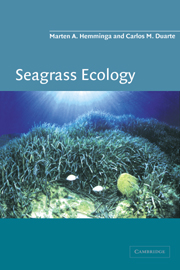Preface
Published online by Cambridge University Press: 29 September 2009
Summary
Only a few decades ago, seagrass ecology was a virtually non-existent field within marine ecology. In the past 30 years or so, this situation has drastically changed. As a recent analysis of published papers by one of us (CMD; Aquatic Botany 65: 7–20) indicates, current publication rates on seagrass ecology in the international scientific literature are at a level of approximately 100 papers per year, and these rates are still increasing. The growing awareness of the role that seagrasses play in ecology, and in the regulation of the biogeochemical cycles of the coastal zones worldwide, undoubtedly does much to stimulate this ongoing expansion of research efforts. The increase in the number of studies also implies that the community of researchers that enters the field of seagrass studies is growing. Besides the scientists, there is also an expanding community of professionals working in governmental and non-governmental organizations in countries all over the world, which in the context of coastal management or conservation issues are actively involved in seagrass matters.
This book is intended to provide an introduction to the field of seagrass ecology. In the first place it is designed for students and for scientists who enter an area as yet unfamiliar to them. In the second place, we hope that the book will also serve as a source of information for those involved in management and conservation of coastal areas that harbour seagrasses.
- Type
- Chapter
- Information
- Seagrass Ecology , pp. ix - xiiPublisher: Cambridge University PressPrint publication year: 2000
- 1
- Cited by

